How to Play Yu-Gi-Oh!: All Sorts of Special Summoning
Welcome back to our discussion of Yu-Gi-Oh! rules. In this instalment we will be covering all types of Special Summoning, including Fusion, Ritual, Synchro, Xyz and Pendulum.
Special Summoning
Special Summoning in Yu-Gi-Oh is a blanket term for a number of different methods of summoning, only really united by the fact that they are not your single Normal Summon for the turn! Of these, there are two major types which affect the interaction between cards: the Inherent Special Summon and the non-Inherent Special Summon. Cyber Dragon 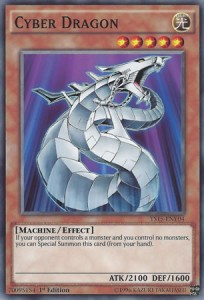 (pictured) is an example of an Inherent Special Summon – its effect allows it to be Special Summoned from the hand, but this does not start a chain. You do not have to activate the effect, but rather you have the option to just Special Summon it as long as its condition is fulfilled! Inherent Special Summons are those which do not start chains, and are simply options which you have given the fulfilment of certain conditions. Synchro, Xyz and Pendulum Summons are all Inherent Special Summons.
(pictured) is an example of an Inherent Special Summon – its effect allows it to be Special Summoned from the hand, but this does not start a chain. You do not have to activate the effect, but rather you have the option to just Special Summon it as long as its condition is fulfilled! Inherent Special Summons are those which do not start chains, and are simply options which you have given the fulfilment of certain conditions. Synchro, Xyz and Pendulum Summons are all Inherent Special Summons.
Non-Inherent Special Summons are effects which start a chain. 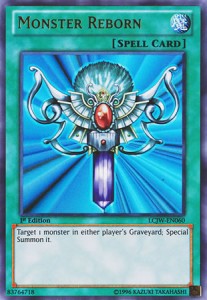 These effects often affect other cards, such as the Spell Card Monster Reborn (pictured). Essentially, when an effect activates which would Special Summon a monster, that is a non-Inherent Special Summon. Therefore, cards such as Soul Charge are non-Inherent, as their effects activate, and equally all Ritual and Fusion Summons are non-Inherent.
These effects often affect other cards, such as the Spell Card Monster Reborn (pictured). Essentially, when an effect activates which would Special Summon a monster, that is a non-Inherent Special Summon. Therefore, cards such as Soul Charge are non-Inherent, as their effects activate, and equally all Ritual and Fusion Summons are non-Inherent.
But what difference does this make? Simply put, several cards in the game can only affect one or the other of 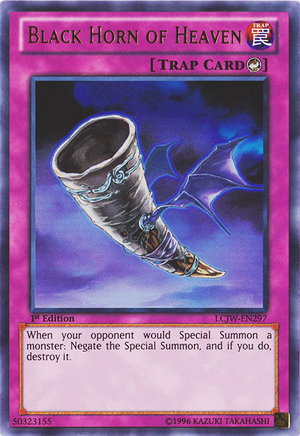 these two major types. Black Horn of Heaven (pictured) can only be used to negate the Inherent Special Summons of monsters. Why? The wording of the card is ‘When your opponent would Special Summon a monster’, not ‘When your opponent would activate an effect which would Special Summon a monster’. This means that only actions which are inherently Special Summons can be negated – limiting Black Horn of Heaven to only affecting Synchro, Xyz, Pendulum and Cyber Dragon-like Summons
these two major types. Black Horn of Heaven (pictured) can only be used to negate the Inherent Special Summons of monsters. Why? The wording of the card is ‘When your opponent would Special Summon a monster’, not ‘When your opponent would activate an effect which would Special Summon a monster’. This means that only actions which are inherently Special Summons can be negated – limiting Black Horn of Heaven to only affecting Synchro, Xyz, Pendulum and Cyber Dragon-like Summons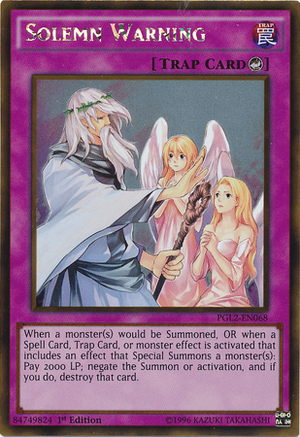 . Solemn Warning (pictured), on the other hand, can stop every type of Summon. This is because it can remove any Inherent Special or Normal Summon (‘when a monster(s) would be Summoned’ or any effect which can Special Summon a monster (‘when… an effect is activated… that Special Summons a monster(s’). As such, it is really important to learn the difference between the two types, as it does change what tools you can use to respond to them!
. Solemn Warning (pictured), on the other hand, can stop every type of Summon. This is because it can remove any Inherent Special or Normal Summon (‘when a monster(s) would be Summoned’ or any effect which can Special Summon a monster (‘when… an effect is activated… that Special Summons a monster(s’). As such, it is really important to learn the difference between the two types, as it does change what tools you can use to respond to them!
Ritual Summoning (Non-Inherent)
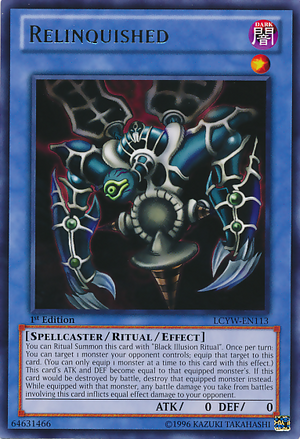
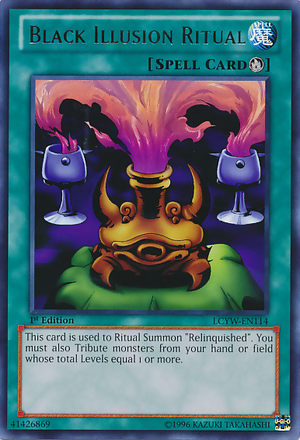 Ritual monsters are kept in the Main Deck and must be summoned in a certain way, requiring the user to have two specific cards. Relinquished is an example of a Ritual monster, and can be summoned using the Ritual Spell Card ‘Black Illusion Ritual’. When the player activates the Black Illusion Ritual, they Tribute monsters from their hand or field according to the conditions written on the Spell Card. This is not a cost, but rather part of the effect, so if your opponent negates the Spell, you do not lose your monsters. At that point, you summon a copy of the appropriate Ritual Monster from your hand. This completes the summon, allowing the opponent to respond with cards such as Bottomless Trap Hole. Ritual Monsters are therefore one of the hardest types of Monster to summon, as they require a very specific combination of cards in hand to use. Further, Ritual Monsters sent to the Grave from the hand or deck cannot be Special Summoned using other effects – they have to be Ritual Summoned first! Therefore, you can only use cards such as Monster Reborn on them after you have already Ritual Summoned them, limiting their use even further. Ritual Summoning has become more popular recently given the advent of the Nekroz and Prediction Princess archetypes, as they can help to recover the heavy cost of Ritual Summoning through secondary effects on their Spell Cards.
Ritual monsters are kept in the Main Deck and must be summoned in a certain way, requiring the user to have two specific cards. Relinquished is an example of a Ritual monster, and can be summoned using the Ritual Spell Card ‘Black Illusion Ritual’. When the player activates the Black Illusion Ritual, they Tribute monsters from their hand or field according to the conditions written on the Spell Card. This is not a cost, but rather part of the effect, so if your opponent negates the Spell, you do not lose your monsters. At that point, you summon a copy of the appropriate Ritual Monster from your hand. This completes the summon, allowing the opponent to respond with cards such as Bottomless Trap Hole. Ritual Monsters are therefore one of the hardest types of Monster to summon, as they require a very specific combination of cards in hand to use. Further, Ritual Monsters sent to the Grave from the hand or deck cannot be Special Summoned using other effects – they have to be Ritual Summoned first! Therefore, you can only use cards such as Monster Reborn on them after you have already Ritual Summoned them, limiting their use even further. Ritual Summoning has become more popular recently given the advent of the Nekroz and Prediction Princess archetypes, as they can help to recover the heavy cost of Ritual Summoning through secondary effects on their Spell Cards.
Fusion Summoning (Non-Inherent)
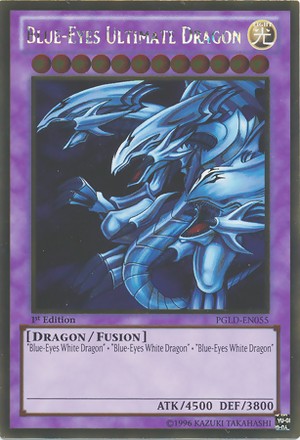 Fusion Summoning is, in many respects, similar to Ritual Summoning. However, they do differ substantially. Fusion Monsters are kept in the Extra Deck until they are able to be used, and Fusion Summons rely on activating a Spell Card with the effect of Fusion Summoning a monster. This can be one of several cards, and it is notable that Fusion Summons do not specify which Spell Card you should use, merely the specific monsters you need. This means that, without specific instructions, you could use any appropriate Fusion Spell Card to summon Blue-Eyes Ultimate Dragon (pictured), provided you use the three Blue-Eyes White Dragon as its Tributes.
Fusion Summoning is, in many respects, similar to Ritual Summoning. However, they do differ substantially. Fusion Monsters are kept in the Extra Deck until they are able to be used, and Fusion Summons rely on activating a Spell Card with the effect of Fusion Summoning a monster. This can be one of several cards, and it is notable that Fusion Summons do not specify which Spell Card you should use, merely the specific monsters you need. This means that, without specific instructions, you could use any appropriate Fusion Spell Card to summon Blue-Eyes Ultimate Dragon (pictured), provided you use the three Blue-Eyes White Dragon as its Tributes. 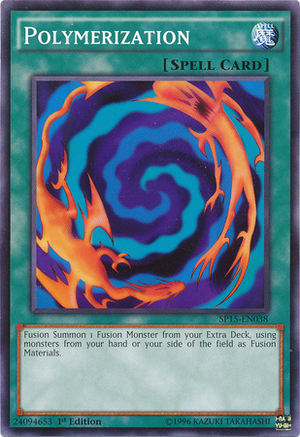 The most common Fusion Spell card is Polymerisation, although there are many more types of cards which can be used, such as Dragon’s Mirror! As such, many players will use those best suited to their deck, as the more specific Spell Cards are often more powerful. Further, some monsters, such as The Dark – Hex-Sealed Fusion, can be used as substitutes for a Fusion Material monster or to provide the effect to Fusion Summon. This means that, while Spell Cards are the primary way for the summoning to happen, other effects can be used as well. When a Fusion Monster would be returned to the hand or the deck, it instead returns to the Extra Deck, though they can be banished or destroyed as usual.
The most common Fusion Spell card is Polymerisation, although there are many more types of cards which can be used, such as Dragon’s Mirror! As such, many players will use those best suited to their deck, as the more specific Spell Cards are often more powerful. Further, some monsters, such as The Dark – Hex-Sealed Fusion, can be used as substitutes for a Fusion Material monster or to provide the effect to Fusion Summon. This means that, while Spell Cards are the primary way for the summoning to happen, other effects can be used as well. When a Fusion Monster would be returned to the hand or the deck, it instead returns to the Extra Deck, though they can be banished or destroyed as usual.
Xyz Summoning (Inherent)
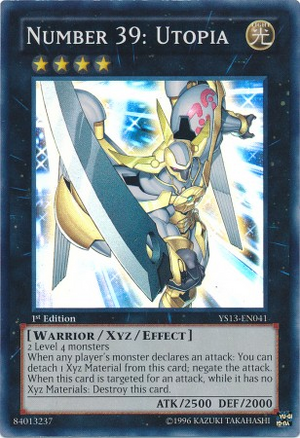 Xyz monsters are kept in the Extra Deck until they are ready to be used, and may be Summoned when you control two or more monsters with the same level on the field. This does not have to be their original level, so any level modifying effects (such as the Gagaga series) can be used to help create them. Number 39: Utopia’s summoning requirement is two level 4 monsters: when you have these on the field, you place the one on top of the other (order does not matter), then the Xyz monster on top of them both. The two monsters used in its summon become ‘Xyz materials’, and are often used as fuel for its effects. For example, Utopia may detach one material from itself to negate an attack – the material leaves the stack under the card and is sent to the Graveyard. On this note, Xyz materials do not count as leaving the field when used as material, so effects such as that of Reborn Tengu cannot activate. Further, Xyz monsters do not have a level, but rather a rank – this is shown by their black stars and their position on the left, rather than the right, of the card. As such, Xyz materials are immune to all effects which are dependent on level, such as Level Limit – Area B. When Xyz monsters are returned to the hand or deck, they instead return to the Extra Deck.
Xyz monsters are kept in the Extra Deck until they are ready to be used, and may be Summoned when you control two or more monsters with the same level on the field. This does not have to be their original level, so any level modifying effects (such as the Gagaga series) can be used to help create them. Number 39: Utopia’s summoning requirement is two level 4 monsters: when you have these on the field, you place the one on top of the other (order does not matter), then the Xyz monster on top of them both. The two monsters used in its summon become ‘Xyz materials’, and are often used as fuel for its effects. For example, Utopia may detach one material from itself to negate an attack – the material leaves the stack under the card and is sent to the Graveyard. On this note, Xyz materials do not count as leaving the field when used as material, so effects such as that of Reborn Tengu cannot activate. Further, Xyz monsters do not have a level, but rather a rank – this is shown by their black stars and their position on the left, rather than the right, of the card. As such, Xyz materials are immune to all effects which are dependent on level, such as Level Limit – Area B. When Xyz monsters are returned to the hand or deck, they instead return to the Extra Deck.
Synchro (Inherent)
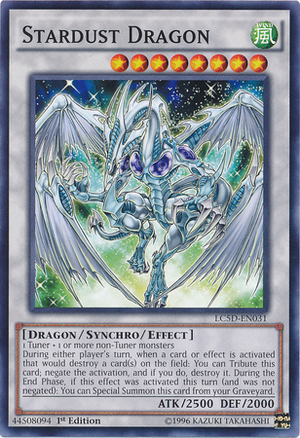 Synchro monsters are kept in the Extra Deck until they are ready to be used, and need to be summoned in a specific way. All Synchro monsters require a Tuner and a non-Tuner monster to be on the field for their summon, although some require multiple Tuners or non-Tuners. Stardust Dragon (pictured) requires exactly one Tuner and at least one non-Tuner – this means you can use any number of non-Tuner monsters (including Tokens) to summon it. However, the levels of the Monsters used as Synchro Material need to add up exactly to the Synchro Monster’s level, which in this case is 8. Therefore, you could use a level 5 Tuner with a level 3 non-Tuner; a level 2 Tuner with two level 3 non-Tuners; or even a level 2 tuner with three level 2 non-Tuners. As long as the level adds up to 8, you can use as many monsters as you need. The monsters used for the summon are sent to the Graveyard, so effects such as Reborn Tengu will activate at this time, as the monsters used are considered to have left the field. Further, as with Xyz monsters, any effects which return Synchro monsters to the hand or deck return them to the Extra Deck instead.
Synchro monsters are kept in the Extra Deck until they are ready to be used, and need to be summoned in a specific way. All Synchro monsters require a Tuner and a non-Tuner monster to be on the field for their summon, although some require multiple Tuners or non-Tuners. Stardust Dragon (pictured) requires exactly one Tuner and at least one non-Tuner – this means you can use any number of non-Tuner monsters (including Tokens) to summon it. However, the levels of the Monsters used as Synchro Material need to add up exactly to the Synchro Monster’s level, which in this case is 8. Therefore, you could use a level 5 Tuner with a level 3 non-Tuner; a level 2 Tuner with two level 3 non-Tuners; or even a level 2 tuner with three level 2 non-Tuners. As long as the level adds up to 8, you can use as many monsters as you need. The monsters used for the summon are sent to the Graveyard, so effects such as Reborn Tengu will activate at this time, as the monsters used are considered to have left the field. Further, as with Xyz monsters, any effects which return Synchro monsters to the hand or deck return them to the Extra Deck instead.
Pendulum (Inherent)
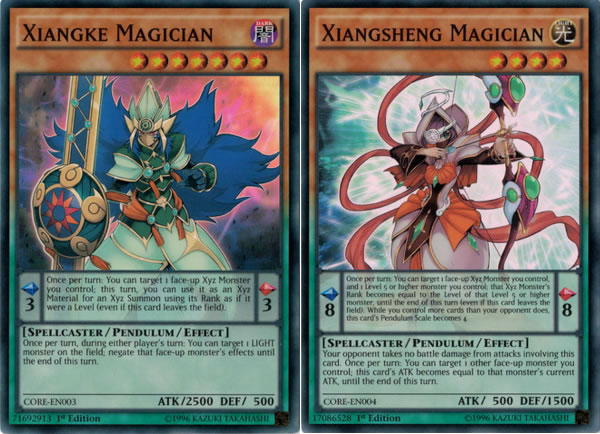 Pendulum monsters are the newest type of Special Summoning, and often are considered the most confusing. Pendulum is a secondary Type of monster, meaning that they go in whichever deck that monster would normally be in. Xiangke Magician, therefore, would go in the Main Deck, while Odd-Eyes Rebellion Dragon (the only Xyz Pendulum) would stay in the Extra Deck. Pendulum monsters are a hybrid between Continuous Spell and Monster Cards, and may be played in two different ways. The most obvious way is just like any other monster card, in which case the lower of the two effect boxes applies – in the case of Xiangke Magician, this is the box containing [Spellcaster/Pendulum/Effect]. This is considered their ‘Monster Effect’. However, they also have a Spell form. When they are played in this way, you may place them face-up in one of your two Pendulum Zones (you cannot set in a Pendulum zone), and they then count as Continuous Spell Cards. At this point, there are two very important pieces of information. The first is their Spell Effect, shown in the upper of the two boxes on the card. In the case of Xiangke Magician, this reads ‘Once per turn: You can target 1 face-up Xyz Monster…’. The second piece of information is their Pendulum Scale. These are shown by the two arrows on either side of the Spell Effect, which in the case of Xiangke Magician is 3. When both of your Pendulum Zones are occupied (for this example, we shall use Xiangsheng Magician as the card in the other zone), once per turn you may perform a Pendulum Summon. This allows you to summon as many monsters as you like from your hand or face-up from your Extra Deck with levels between the scale. So, with a Pendulum Scale of 3 and 8, you are allowed to summon monsters with levels 4, 5, 6 and 7. This is not considered to be activating an effect, so Pendulum summoning is Inherent – as such, cards like Black Horn of Heaven can be activated in response to the summon. But how do you get face-up cards in the Extra Deck? All Synchro, Fusion and Xyz monsters remain face-down at all times in the Extra Deck, even if returned there by an effect. You get face-up cards in the Extra Deck when Pendulum Monsters (even if used as Spells) on the field would be sent to the Graveyard – instead, they move to the Extra Deck face-up, ready to be summoned back by using the Pendulum scale. Therefore, using Pendulum monsters on the field for Tribute Summoning, Ritual Summoning, Synchro Summoning or Fusion Summoning will return them to the Extra Deck, while using them for Xyz material will result in them going to the Grave when detached, as they are not on the field. Pendulum monsters (even if used as Spell cards) must be on the field to return to the Extra Deck – negating their activation or summon will send them to the Graveyard, just like any other type of monster. When they are returned to the hand or deck, they behave normally too.
Pendulum monsters are the newest type of Special Summoning, and often are considered the most confusing. Pendulum is a secondary Type of monster, meaning that they go in whichever deck that monster would normally be in. Xiangke Magician, therefore, would go in the Main Deck, while Odd-Eyes Rebellion Dragon (the only Xyz Pendulum) would stay in the Extra Deck. Pendulum monsters are a hybrid between Continuous Spell and Monster Cards, and may be played in two different ways. The most obvious way is just like any other monster card, in which case the lower of the two effect boxes applies – in the case of Xiangke Magician, this is the box containing [Spellcaster/Pendulum/Effect]. This is considered their ‘Monster Effect’. However, they also have a Spell form. When they are played in this way, you may place them face-up in one of your two Pendulum Zones (you cannot set in a Pendulum zone), and they then count as Continuous Spell Cards. At this point, there are two very important pieces of information. The first is their Spell Effect, shown in the upper of the two boxes on the card. In the case of Xiangke Magician, this reads ‘Once per turn: You can target 1 face-up Xyz Monster…’. The second piece of information is their Pendulum Scale. These are shown by the two arrows on either side of the Spell Effect, which in the case of Xiangke Magician is 3. When both of your Pendulum Zones are occupied (for this example, we shall use Xiangsheng Magician as the card in the other zone), once per turn you may perform a Pendulum Summon. This allows you to summon as many monsters as you like from your hand or face-up from your Extra Deck with levels between the scale. So, with a Pendulum Scale of 3 and 8, you are allowed to summon monsters with levels 4, 5, 6 and 7. This is not considered to be activating an effect, so Pendulum summoning is Inherent – as such, cards like Black Horn of Heaven can be activated in response to the summon. But how do you get face-up cards in the Extra Deck? All Synchro, Fusion and Xyz monsters remain face-down at all times in the Extra Deck, even if returned there by an effect. You get face-up cards in the Extra Deck when Pendulum Monsters (even if used as Spells) on the field would be sent to the Graveyard – instead, they move to the Extra Deck face-up, ready to be summoned back by using the Pendulum scale. Therefore, using Pendulum monsters on the field for Tribute Summoning, Ritual Summoning, Synchro Summoning or Fusion Summoning will return them to the Extra Deck, while using them for Xyz material will result in them going to the Grave when detached, as they are not on the field. Pendulum monsters (even if used as Spell cards) must be on the field to return to the Extra Deck – negating their activation or summon will send them to the Graveyard, just like any other type of monster. When they are returned to the hand or deck, they behave normally too.
Conclusion
In this instalment, we have learned the difference between Inherent and Non-Inherent types of Special Summoning, as well as how to perform each type of Special Summon in the game.
Yu-Gi-Oh! singles are available to purchase at Big Orbit Cards: Yu-Gi-Oh!
